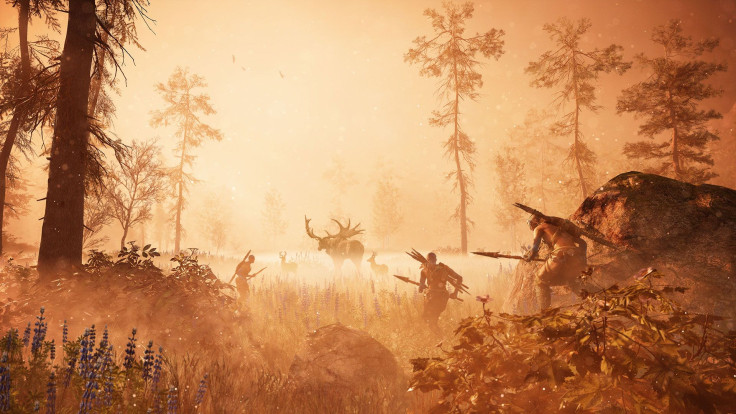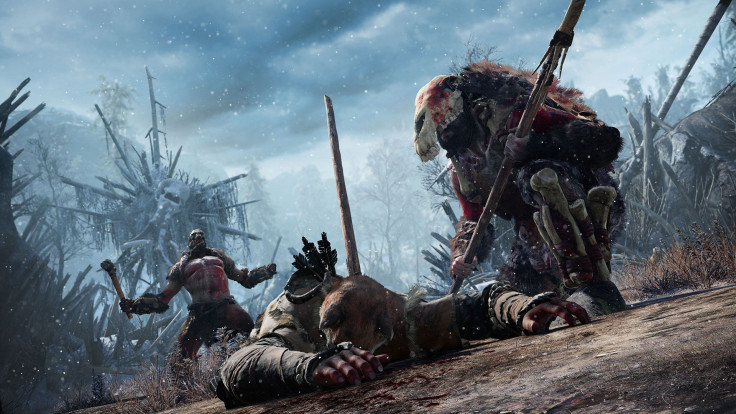Far Cry Primal looks back to the distant past. The game—which comes out on Feb. 23—takes the Stone Age violence of the Far Cry series back to its original home, the Stone Age itself. And Ubisoft has pushed hard to make the game as immersive as possible, to feel like the Stone Age actually felt. Immersion relies on realism. In Far Cry 4, the residents of the Himalayan country of Kyrat all spoke English. It was a hand-wave for everyone’s convenience, but didn’t build that stranger-in-a-strange-land feel the narrative sought out. Far Cry Primal takes a different route. Instead of forcing the King’s English out of the mouths of primitive man, Far Cry Primal features a real language that was actually spoken many thousands of years ago. It’s called Proto-Indo-European, and Ubisoft hired Andrew and Brenna Byrd to lead the team of linguists who brought ancient language into Far Cry Primal. “I’m an Indo-Europeanist, and a few years ago I did some recordings of Proto-Indo-European,” Andrew tells iDigitalTimes. The recordings of Indo-European fables for Archaeology magazine went “kind of viral, and Ubisoft found us through those,” says Brenna.
Far Cry Primal And The Language Of The Wenja
There aren’t many experts in Proto-Indo-European, and fewer still have experience actually speaking it. Husband-and-wife team Andrew Byrd, Assistant Professor of Linguistics at the University of Kentucky, and Brenna Byrd, Assistant Professor of German Studies at the University of Kentucky, are the rare exception. That’s how they ended up leading a team of UCLA linguists to recreate and adapt Proto-Indo-European for Far Cry Primal.
What’s more, Proto-Indo-European—a language that was last spoken six or seven thousand years ago, probably on the steppes near the Black and Caspian Seas—was a little too newfangled and modern for Ubisoft’s taste. So Far Cry Primal projected the language even farther back into the mists of time, creating what the Byrds call a “proto-Proto-Indo-European.”
Each of the three main tribes in Far Cry Primal—the Wenja, the Udam and the Izila—speaks a slightly different language. The Izila speak the purest form of Proto-Indo-European, modified slightly for a game setting, but the Wenja and the Udam are more primitive. “We decided to give them a more archaic form of the language,” Andrew says. And that’s how Far Cry Primal ended up with three different Stone Age languages.
Far Cry Primal And Our Real, Actual Past

“I want people to feel a sense of wonder,” Andrew says. “I want them to play the game and jump into the water, and the Udam chasing them yells out ‘wódr,’ and the player says—wait, that’s crazy. Why does that word sound like ‘water’? Why is it the same word?” Because it is, in essence, the same word. Proto-Indo-European isn’t any old lost language of the Stone Age. It’s a proto-language, the ancestor of all the Indo-European languages—a group of over 400 languages spoken from England to India by around 3 billion people. That’s nearly half the world. The language of the Izila in Far Cry Primal is the common ancestor of the Germanic languages, the Romance languages, the Slavic languages, Greek, Sanskrit and most of the modern languages of India. “I want people to say, wait a minute—English is connected to all these languages spoken around the world?” Andrew says. “It’s really magical. And typically only people who studied Latin and Greek know about it.”
Warning: Extreme Detail About Proto-Indo-European Follows
That’s why Proto-Indo-European is in Far Cry Primal. But how? How is an unwritten language from thousands of years ago in the game? That’s right, folks—we’re about to do a deep dive into the grammar and linguistics behind Far Cry Primal.
The people who spoke Proto-Indo-European didn’t leave any written records. The language has been developed and refined for over a century and was discovered by looking in reverse. “You can construct backwards from languages that are similar,” Brenna explains. The English word ‘father,’ the Latin word ‘pater’ and the German word ‘vater’ are all obviously similar, suggesting a common root. The academic scholarship behind Proto-Indo-European is a lot more complicated than that, but you get the idea. “Thousands of words, the whole grammar, the word order—everything can be reconstructed,” Andrew says. For the Izila language, the Byrds largely stuck to the standard academic version of Proto-Indo-European. “This is the UCLA version of Proto-Indo-European,” Brenna says. “Everyone collaborated and was able to veto stuff. But it’s a very widely accepted version of Proto-Indo-European.” Andrew agrees. “There are some simplifications to make it a little easier to say and in grammar and pronunciation, but not that many,” he says.
Moving the scholastic version of Proto-Indo-European into Far Cry Primal had its challenges. There are yaks in Far Cry Primal, for instance. There’s no known word for yak in Proto-Indo-European. One solution: Make compounds. There’s no word for yak, but there were words for “shaggy cow.” A four-syllable-long compound that sounds roughly like “Donsugawe.” In Far Cry Primal, it’s rendered as “Dong.”
That’s not just for expedience, although the Byrds admit that’s part of it. “You can’t have too many syllables in a game, because it just takes too long to say things,” Andrew says. But it’s also natural. “At first, we were a little troubled by how short we were making things,” Brenna says. “But if you think about modern language, we shorten things all the time—especially if you’re yelling things out. ‘Beware of the shaggy cow’ is a little long. You just yell out, ‘Hey! Cow!’” Other frequently used words also shorten tremendously over time. “The word ‘goodbye’ used to be ‘God be with you,’ and got shortened,” Brenna explains. “This is normal stuff within any language.”
Seems like those Proto-Indo-European types weren’t so different from us after all. You know, besides for living in a world that’s almost totally unrecognizable today. Other than that.
Proto-Proto-Indo-European: How Far Cry Primal Made One Of The Oldest Languages Even Older

The Wenja and Udam languages in Far Cry Primal are even older than Izila, but it’s not a contradiction to have languages with older features coexisting. “Proto-Indo-European wasn’t a monolithic entity without dialects,” Andrew says. Brenna agrees. “So little was written down, and those things weren’t standardized anyhow,” she says.
Still, the Wenja and Udam languages represent an older form of the language, and creating it was itself quite systematic. “It’s the irregular features, the weird stuff, that’s usually the oldest,” Brenna says. She cites the verb ‘email.’ To put it in the past tense, just add ‘-ed.’ ‘Emailed.’ Easy peasy lemon squeazy. “That’s the most recent way to make a past tense, but for some of the more common verbs, you have things like ‘sing, sang, sung’ and ‘drink, drank, drunk.’ For Wenja, we looked at archaic features of Proto-Indo-European and imagined those features were the normal way to do things.” Difficult dificult lemon difficult. The process is called internal reconstruction, and it’s one of the techniques that was used to create Proto-Indo-European in the first place.
So what kind of language is Wenja? Word order–wise, it’s SOV—Subject, object, verb (for example, ‘I Far Cry Primal play’). Well, Proto-Indo-European has a case system, meaning it’s an inflected language. Yup, I’m talking about the case system on a gaming site, all because of Far Cry Primal, and luckily my editor isn’t allowed to cut this part [citation needed]. “Cases historically tend to come from actual words,” Andrew says. “We looked at some of the cases in Proto-Indo-European and we assumed them to be full words in Wenja—things that didn’t have to be directly attached to the noun.” Same thing for verbal endings—in Wenja, they don’t have to be attached directly to the verb.
“Wenja is inflected, but the inflections aren’t suffixes or affixes—they’re clitics,” Andrew says,. For example, the word ‘ta’ means ‘you.’ Sometimes it will be attached to other words as a suffix, but sometimes it will stand on its own. “Ta wenja.” You’re a Wenja. “You’ll hear that ‘ta’ coming up, usually when people are talking to you,” Brenna says. “Usually, they’re saying, ‘I’m going to kill you!’”
And when your enemies scream this at you in Far Cry Primal, it won’t matter whether you know the intricacies of the grammar. You’ll feel it. And a spear in your chest sends the signal well enough.

















